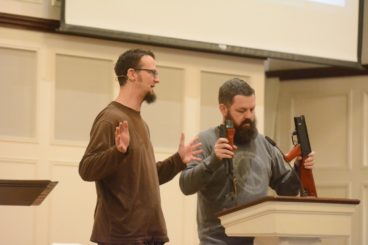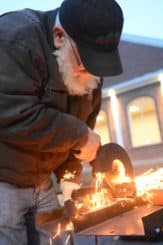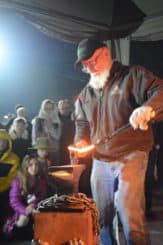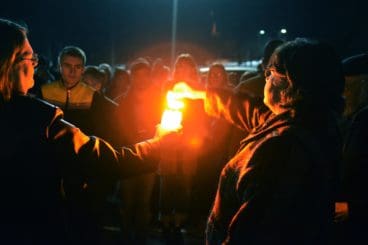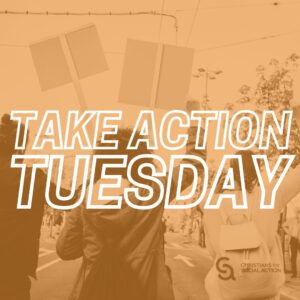In the book Beating Guns, authors Shane Claiborne and Mennonite blacksmith Michael Martin take a frank look at our country with regards to gun violence. In their thirty-seven-city Beating Guns Tour, Shane and Michael feature the live transformation of a gun into a garden tool at each stop…and mix worship, song, prayer, art, and stories as a call to look into our own hearts and see that this is not only a gun issue but a heart issue.
|
|
|
|
I recently had the opportunity to attend the Beating Guns Tour when it stopped at the Neffsville Mennonite Church in Lancaster, PA. During the worship time, we sang the spiritual “Ain’t Gonna Study War No More.” For those of us over 50 years old, it took us back to the anti-Vietnam war movement.
Patrica “PJ” Rainey, a nineteen-year-old young woman from Philadelphia, shared the story of being shot in an eye by a gun, and losing that eye when she was barely a teenager. For those of us who are parents, it tugged at our hearts. |
Herman Bontrager told the story of the Amish school shooting, how Charlie Roberts killed or maimed many Amish school students, and how the Amish community went on to offer forgiveness and friendship to his family. For those of us from Lancaster County, it took us back to the day we heard the sirens and saw helicopters heading to that horrific crime scene. But also warmed our hearts that the power of forgiveness was told around the world.
|
|
|
|
When the crowd was invited to go outside to the anvil, hammer and forge in the church parking lot, we were invited to write down the heavy things in our hearts on flash paper. Then outside, at the artist’s tent, we could hold the flash paper in a candle’s flame, lighting it, and then throw it into the air and watch it disappear. For those of us who participated in this exercise, our hearts were made lighter and we felt God’s touch. |
At the artist’s tent, we were refreshed with live worship music and prayer. We were transfixed as we watched Fred Martin, the father of Michael, beat the cherry-red gun barrel into a garden tool. We were invited, if we had personally felt the effects of gun violence in our lives, to also take up the hammer and hit the hot metal. We were touched as we saw the transformation: the metal of a gun that could have been use for violence being made into a garden tool—a garden tool that we would use on our knees, calling us always back to a position of prayer.
|
|
Dale D. Gehman is a freelance photographer and video producer in Lancaster, PA. His video production The Lancaster Amish is shown in the theater of the Mennonite Information Center in Lancaster, six days a week. All images appearing here ©Dale D. Gehman.

